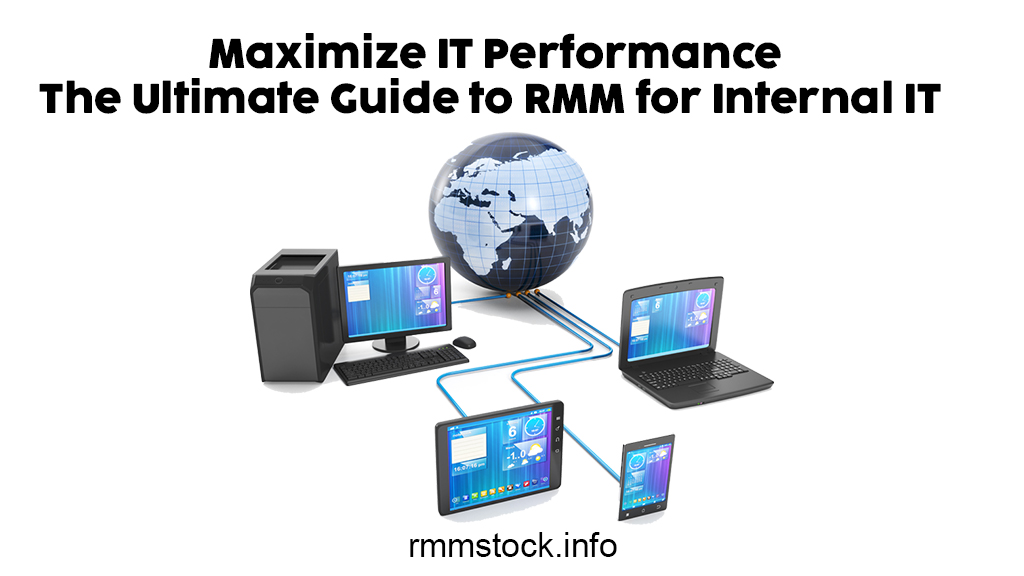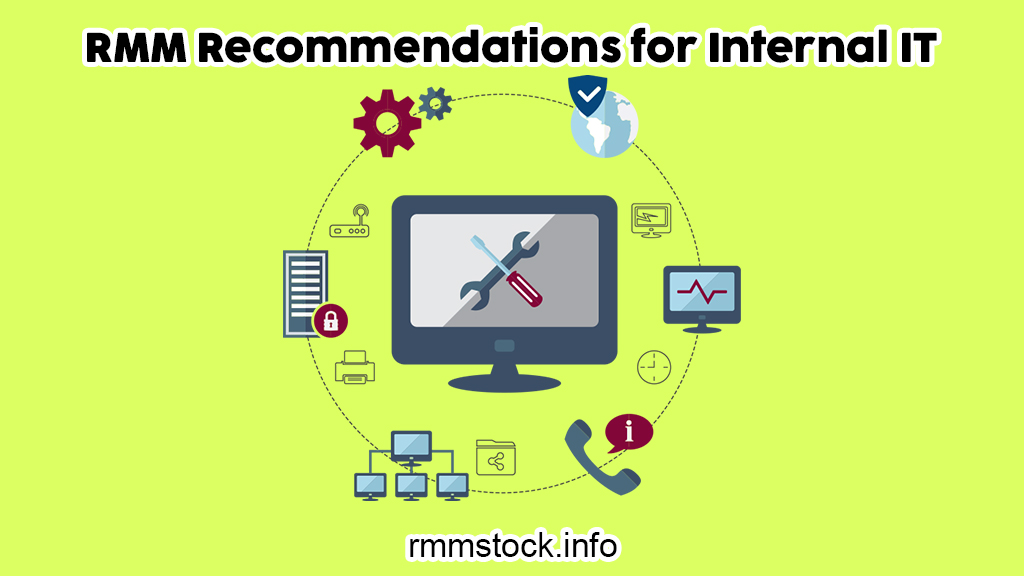As organizations grow, managing this infrastructure becomes more complex and demanding. This is where RMM for internal IT steps in, offering a transformative solution.
RMM tools, traditionally used by Managed Service Providers (MSPs) to oversee client systems, are now being harnessed by internal IT teams to streamline operations, enhance security, and boost overall productivity.
Imagine a world where your IT team can monitor the health of your entire network, detect potential issues before they escalate, and automate routine maintenance tasks—all from a remote location. This isn’t a futuristic dream; it’s the reality that RMM brings to modern businesses.
By integrating RMM into your IT strategy, you can not only improve the efficiency of your IT operations but also ensure a more secure and resilient IT environment. Let’s delve deeper into the myriad benefits and applications of RMM for internal IT and discover how it can propel your organization to new heights of success.
Understanding RMM for Internal IT
Remote Monitoring and Management (RMM) is a powerful technology designed to help IT professionals monitor and manage endpoints, networks, and computers remotely. Initially developed for Managed Service Providers (MSPs) to oversee client systems, RMM tools have evolved to become indispensable for internal IT departments. As organizations expand and their digital ecosystems grow more complex, maintaining control over every component of the IT infrastructure becomes a daunting task. This is where RMM solutions shine.
By deploying RMM, internal IT teams gain the capability to proactively monitor the health and performance of their entire IT infrastructure. This includes everything from desktops and servers to network devices and mobile endpoints. With real-time monitoring, IT professionals can quickly identify issues such as system failures, network bottlenecks, or security vulnerabilities before they escalate into major problems. This proactive approach not only minimizes downtime but also enhances the overall reliability and performance of IT services.
Moreover, RMM tools allow for the automation of routine tasks, freeing up IT staff to focus on more strategic initiatives. Automated processes can include software updates, patch management, data backups, and even the deployment of new applications or services. This level of automation ensures that these critical tasks are performed consistently and on schedule, reducing the risk of human error and enhancing the efficiency of IT operations.
Benefits of Implementing RMM in Internal IT
- Comprehensive Visibility
- Provides real-time monitoring of system health, performance metrics, and security statuses.
- Enables early identification of potential problems, allowing for preventive measures to avoid costly downtime.
- Automation of Routine Maintenance Tasks
- Automates software updates, patch management, and data backups.
- Reduces workload on IT staff, ensuring consistent and timely execution of critical tasks.
- Minimizes the risk of human error.
- Improved Efficiency
- Streamlines IT operations, allowing staff to focus on more strategic tasks.
- Enhances productivity by automating repetitive and time-consuming tasks.
- Enhanced Security
- Monitors security statuses continuously, identifying vulnerabilities early.
- Ensures timely updates and patches, reducing exposure to security threats.
- Cost Savings
- Prevents downtime and related costs by identifying and addressing issues proactively.
- Reduces labor costs by automating routine tasks and optimizing resource allocation.
- Scalability
- Easily scalable to accommodate the growth of the IT environment.
- Adapts to increasing numbers of devices and endpoints without additional strain on IT resources.
- Remote Management
- Allows IT professionals to manage and resolve issues remotely, increasing flexibility.
- Reduces the need for on-site visits, saving time and travel costs.
- Improved Compliance
- Ensures compliance with industry standards and regulations by automating update and patch processes.
- Provides detailed reporting and audit trails for regulatory purposes.
- Better Resource Allocation
- Frees up IT staff to focus on high-priority projects and strategic initiatives.
- Optimizes use of IT resources, improving overall operational efficiency.
- Proactive Maintenance
- Enables proactive identification and resolution of issues before they impact end-users.
- Improves system reliability and performance through regular maintenance and updates.
- Detailed Reporting and Analytics
- Provides detailed insights into IT infrastructure performance and health.
- Facilitates data-driven decision-making and continuous improvement of IT operations.
Many organizations have successfully implemented Remote Monitoring and Management (RMM) solutions in their internal IT departments, reaping significant benefits. Here are a few notable examples:
- Mid-Sized Manufacturing Company: A mid-sized manufacturing company implemented an RMM solution to monitor and manage their network of production machines and office computers. By automating routine maintenance tasks and monitoring system health in real-time, the company reduced downtime by 30% and significantly improved overall operational efficiency. This proactive approach allowed them to identify potential issues before they escalated, ensuring smoother operations and less frequent disruptions.
- Financial Services Firm: A financial services firm utilized RMM tools to enhance their cybersecurity posture. The real-time threat detection and automated patch management capabilities of their RMM solution enabled them to quickly identify and mitigate security threats. This not only ensured the protection of sensitive financial data but also helped them maintain compliance with stringent industry regulations. The firm reported a noticeable decrease in security incidents and a stronger overall security framework.
- Healthcare Organization: A healthcare organization adopted an RMM solution to manage its diverse array of medical devices and IT systems. By centralizing the monitoring and maintenance of these critical systems, they improved the reliability and availability of their services. The RMM tools allowed for rapid response to potential issues, minimizing downtime and ensuring that healthcare professionals had uninterrupted access to the necessary technology to provide patient care.
The Future of RMM in Internal IT
While the benefits of RMM are clear, adopting these solutions is not without its challenges. Organizations should be aware of the following considerations:
- Initial Cost of Implementation: The initial investment required for RMM solutions can be significant, particularly for smaller organizations with limited budgets. This includes the cost of the software itself, as well as any necessary hardware upgrades and the time spent on setup and configuration. It’s essential to conduct a thorough cost-benefit analysis to ensure that the long-term savings and efficiency gains justify the upfront expenses.
- Integration with Existing IT Infrastructure: Integrating RMM tools with existing IT infrastructure and workflows requires careful planning and execution. Inadequate integration can lead to disruptions in daily operations and hinder the effectiveness of the RMM solution. Organizations should allocate sufficient time and resources to the integration process, ensuring compatibility with current systems and minimizing downtime during the transition.
- Training and Skill Development: Ensuring that IT staff are adequately trained to use RMM solutions effectively is crucial for realizing their full potential. Without proper training, IT teams may struggle to leverage all the features and functionalities available, leading to underutilization of the tools. Investing in comprehensive training programs and ongoing skill development can help IT personnel become proficient in using RMM solutions, maximizing their impact on the organization’s operations.
- Scalability and Future-Proofing: As organizations grow and evolve, their IT needs will change. It’s important to choose an RMM solution that can scale with the organization and adapt to future requirements. This involves selecting a flexible and customizable platform that can accommodate new technologies and changing business processes. Regularly reviewing and updating the RMM strategy ensures that the solution remains aligned with the organization’s goals and objectives.
By addressing these challenges and carefully considering their specific needs and circumstances, organizations can successfully implement RMM solutions and unlock significant benefits in terms of efficiency, security, and overall IT management.
Conclusion
Remote Monitoring and Management (RMM) is revolutionizing the way internal IT departments manage their IT infrastructure. By providing comprehensive visibility, enhancing security, boosting productivity, and enabling automation, RMM tools are empowering IT professionals to take a proactive approach to IT management. As organizations continue to navigate the complexities of the digital age, RMM will undoubtedly play a crucial role in ensuring their success and resilience.

